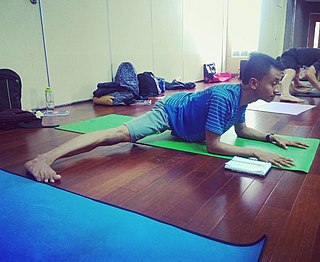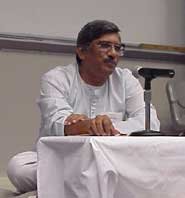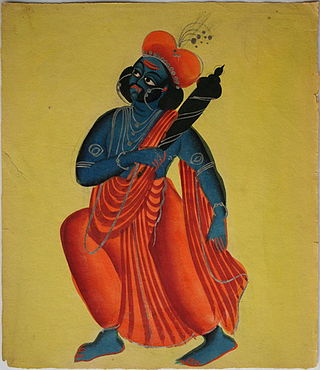In yoga, Ayurveda, and Indian martial arts, prana permeates reality on all levels including inanimate objects. In Hindu literature, prāṇa is sometimes described as originating from the Sun and connecting the elements.

Maharshi Krishna Dvaipayana, better known as Vyasa or Vedavyasa, is a revered sage or ṛṣi portrayed in most Hindu traditions. He is traditionally regarded as the author of the epic Mahābhārata.

The Yoga Sutras of Patañjali is a collection of Sanskrit sutras (aphorisms) on the theory and practice of yoga – 195 sutras and 196 sutras. The Yoga Sutras was compiled in the early centuries CE, by the sage Patanjali in India who synthesized and organized knowledge about yoga from much older traditions.
Vivekananda Kendra is a Hindu nationalist social service and "nation-building" organisation, claiming to represent the heritage of Swami Vivekananda. the organisation is based near the Vivekananda Rock Memorial in Kanyakumari.

Vivekananda Rock Memorial is a monument and popular tourist attraction in Kanyakumari, India's southernmost tip. The memorial stands on one of the two rocks located about 500 meters off mainland of Vavathurai. It was built in 1970 in honour of Swami Vivekananda, who is said to have attained enlightenment on the rock. According to legends, it was on this rock that Goddess Kanyakumari (Parvathi) performed tapas in devotion of lord Shiva. A meditation hall known as Dhyana Mandapam is also attached to the memorial for visitors to meditate. The design of the mandapa incorporates different styles of temple architecture from all over India. The rocks are surrounded by the Laccadive Sea where the three oceans Bay of Bengal, the Indian Ocean and the Arabian Sea meets. The memorial consists of two main structures, the Vivekananda Mandapam and the Shripada Mandapam.

Yoga as therapy is the use of yoga as exercise, consisting mainly of postures called asanas, as a gentle form of exercise and relaxation applied specifically with the intention of improving health. This form of yoga is widely practised in classes, and may involve meditation, imagery, breath work (pranayama) and calming music as well as postural yoga.

P. Parameswaran, often referred to as Parameswarji, was a Rashtriya Swayamsevak Sangh (RSS) pracharak from Kerala, India who was erstwhile Vice‑President of the Jan Sangh.

The Bhagavad Gita, often referred to as the Gita, is a 700-verse Hindu scripture, which is part of the epic Mahabharata. It forms the chapters 23–40 of book 6 of the Mahabharata called the Bhishma Parva. The work is dated to the second half of the first millennium BCE.

N. V. Raghuram is a yoga guru from India.

Eknath Ramakrishna Ranade was a social activist and leader that led the Rashtriya Swayamsevak Sangh.

"Arise awake and stop not till the goal is reached." is a slogan popularized in the late 19th century by Indian Hindu monk Swami Vivekananda, who took inspiration in a sloka of Katha Upanishad. It was his message to the world to get out of their hypnotized state of mind. This shloka is the basis of the title of the book The Razor's Edge and the 1946 film and the 1984 film, and also of various music albums in the west by bands like AC/DC, Dave Holland, etc.
Alexander Maurice Alers Hankey, known as Alex Hankey, is a theoretical physicist trained at Massachusetts Institute of Technology and Cambridge University. He was a post-doctoral fellow at Stanford Linear Accelerator Center. Deeply interested in Vedanta, Yoga, and Ayurveda, he played a vital role in setting up Maharishi University of Management and later on became a professor at it, where he taught the first undergraduate course in philosophy of science. His current work relates to applying a combination of philosophical arguments and knowledge of Vedic sciences to solve the problems within modern science, thereby refining the foundations of physics, biology, and information theory.
Dr. Kodaganur S. Gopinath, MS, FAMS, FRCS (Edin) is an Indian surgical oncologist, known for his pioneering work on oncological research. He is a recipient of many awards including Dr. B. C. Roy Award, considered to be the premier medical honour in the country. The President of India recognised his services to the field of oncology, by awarding him the fourth highest civilian award, Padma Shri, in 2010.
Swami Vivekananda Yoga Anusandhana Samsthana, abbreviated S-VYASA or SVYASA, is a higher education institute deemed to be university located in Bangalore, India. The university is dedicated to the study of yoga based on the teachings of Swami Vivekananda. Dr. B R Ramakrishna is the current Vice Chancellor of the university.
Turaga Desiraju was an Indian neurophysiologist and a professor at National Institute of Mental Health and Neurosciences (NIMHANS). He was associated with AIIMS Delhi before joining NIMHANS and founded the Department of Neurophysiology at NIMHANS in 1975. He was known for his neurophysiological studies on sleep and wakefulness and his extensive studies on the activities of cerebral cortex helped to widen the understanding of conscious behaviour.
Santosh Gajanan Honavar is an Indian ophthalmologist and is currently the editor of the Indian Journal of Ophthalmology and Indian Journal of Ophthalmology - Case Reports, the official journals of the All India Ophthalmological Society; Director, Medical Services ; Director, Department of Ocular Oncology and Oculoplasty at Centre for Sight, Hyderabad; and Director, National Retinoblastoma Foundation.

Venkataram Mysore is a dermatologist, dermatopathologist, and hair transplant surgeon from Bangalore, India. He has over 30 years experience as a dermatologist, 18 years as a teacher and is currently the director of the Venkat Center for Advanced Dermatology and Post-Graduate Training.

Yoga as exercise is a physical activity consisting mainly of postures, often connected by flowing sequences, sometimes accompanied by breathing exercises, and frequently ending with relaxation lying down or meditation. Yoga in this form has become familiar across the world, especially in the US and Europe. It is derived from medieval Haṭha yoga, which made use of similar postures, but it is generally simply called "yoga". Academics have given yoga as exercise a variety of names, including modern postural yoga and transnational anglophone yoga.
Neglected tropical diseases in India are a group of bacterial, parasitic, viral, and fungal infections that are common in low income countries but receive little funding to address them. Neglected tropical diseases are common in India.

Gurus of Modern Yoga is an edited 2014 collection of essays on some of the gurus (leaders) of modern yoga by the yoga scholars Mark Singleton and Ellen Goldberg.












